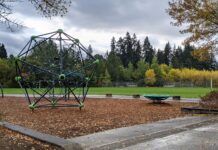BY LOYCE MARTINAZZI
What I know as the Community of Tualatin is not confined by the map lines that limit its official boundaries as an incorporated municipality. Never was! When I was growing up as a rural child in the ‘30s and ‘40s my sisters and I attended Tualatin Elementary and our family communicated with the outside world via a Tigard telephone number and a Sherwood mailing address.
The 95-acre Orr farm is located on the south side of Tulalatin-Sherwood Road, technically within the lines of the City of Sherwood, but I experienced that 95-acre farm as part of my Tualatin community. I first knew the property as the “Clear place” because the great grandparents of Martinazzi family friend Topy Reber were named Clear and their family lived there for some time around the turn of the last century. My dad always called the property the Clear place, and I guess I got that from him. The Martinazzi family was very close to Bill and Grace “Topy” Reber, and Topy’s mother, Lola Smith, lived there with her grandparents, the Clears, who built the house. An interesting aside is that the Clears, according to Dan Reber, either sold or traded the farm for a blacksmith shop located along Boones Ferry and Martinazzi Avenue, close to the bridge. It occurs to me that may have been the location of Billy Greenwood’s smithy in the 1850s.
But I digress, as I usually do when talking about Tualatin history.
The story of what is now known as the 95-acre Orr farm really began when the floods of the last ice age, some 15,000 years ago, deposited fine soils from Montana, Idaho and Washington on the north side of the property along Tualatin-Sherwood Road, but the floods scraped to bedrock the southern portion, part of the Tonquin scablands.
Early on the Atfalati Indians lived on the land, and in 1852 Daniel Sebastian became the holder of 320 acres, the first donation land claim to the property. The land then passed through several different farm owners, and finally in 1942 the Daniel Orr family came from Nebraska to Oregon and bought 160 acres of the land after renting it for a year. Florence, second eldest of the eight Orr children, twice sent her son Terry Pennington to spend time with his Orr grandparents on the farm. Terry recently told me some history of his grandparents’ farm and lent the Tualatin Historical Society some precious black-and-white Brownie photos, which we have gratefully scanned into our archives. And as we all have heard, a picture is worth a thousand words. Being just an old farm girl myself, whose family did not think to record daily farm life with a camera, I deeply appreciate these photos. Although there are no photos to record the events, Glen Orr, Daniel’s son, sold 150 to 200 truckloads of rock that was blasted off the back portion in the 1950s.
Speaking of digressing, here is an amusing story. Terry recently told me that he remembers that around noon in the summer of 1944, a fire truck sped west on the road with siren blaring. “Oh Grandpa,” Terry said, “somebody’s farm is on fire!” Grandpa Orr replied “don’t worry Terry, that’s just the Tualatin Volunteer Firemen going to Sherwood for beer.”
Florence’s brother Ray inherited the Orr farm. By the time Ray passed, the original quarter-section was down to 95 acres, but it was still known as the Orr farm. Since Ray’s death, the land has been listed with a commercial real estate agency, and is zoned for industrial use. From Ice Age to family farm to factory—times change, but perhaps not always for the better. A wise old farmer and friend recently told me that if the Willamette Valley were properly farmed, it could feed the world. As the world’s human population is growing at a rapid rate, some of the richest and most arable land in the world is being covered with concrete.
Is Daniel turning in his grave? And when the land is used for industrial purposes, will we feel it belongs to the Tualatin Community? Questions it would take someone wiser than myself to answer.

Loyce Martinazzi was born and raised in Tualatin and is passionate about Tualatin History. She is Co-Founder of the Tualatin Historical Society and Co-Author of Tualatin…From the Beginning.



















